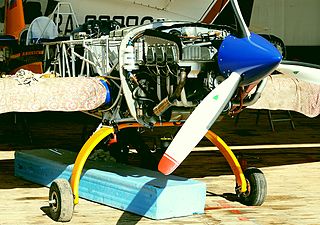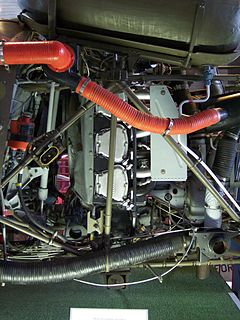
The Allison V-1710 aircraft engine designed and produced by the Allison Engine Company was the only US-developed V-12 liquid-cooled engine to see service during World War II. Versions with a turbocharger gave excellent performance at high altitude in the twin-engined Lockheed P-38 Lightning, and turbo-superchargers were fitted to experimental single-engined fighters with similar results.

Lycoming Engines is a major American manufacturer of aircraft engines. With a factory in Williamsport, Pennsylvania, Lycoming produces a line of horizontally opposed, air-cooled, four, six and eight-cylinder engines including the only FAA-certified aerobatic and helicopter piston engines on the market.

The hyper engine was a 1930s study project by the United States Army Air Corps (USAAC) to develop a high-performance aircraft engine that would be equal to or better than the aircraft and engines then under development in Europe. The project goal was to produce an engine that was capable of delivering 1 hp/in3 (46 kW/L) of engine displacement for a weight of less than 1 lb/hp delivered. The ultimate design goal was an increased power-to-weight ratio suitable for long-range airliners and bombers.

The Jumo 222 was a German high-power multiple-bank in-line piston aircraft engine from Junkers, designed under the management of Ferdinand Brandner of the Junkers Motorenwerke.

The Continental O-300 and the C145 are a family of air-cooled flat-6 aircraft piston engines built by Teledyne Continental Motors.

The Lycoming XR-7755 was the largest piston aircraft engine ever built in the United States, with 36 cylinders totaling about 7,750 in³ (127 L) of displacement and a power output of 5,000 horsepower (3,700 kilowatts). It was originally intended to be used in the "European bomber" that eventually emerged as the Convair B-36. Only two examples were built before the project was terminated in 1946.

The Rolls-Royce Eagle Mk XXII is a British 24-cylinder, sleeve valve, H-block aero engine of 46 litre displacement. It was designed and built in the early-1940s by Rolls-Royce Limited and first ran in 1944. It was liquid-cooled, of flat H configuration with two crankshafts and was capable of 3,200 horsepower at 18 psi boost.

The Curtiss V-1570 Conqueror was a 12-cylinder vee liquid-cooled aircraft engine. Representing a more powerful version of the Curtiss D-12, the engine entered production in 1926 and flew in numerous aircraft.

The Allison V-3420 was a large experimental piston aircraft engine, designed in 1937 by the American Allison Engine Company.

The Wright R-2160 Tornado was an experimental 42-cylinder, 7-cylinder per row, 6-row liquid-cooled inline radial aircraft engine. It was proposed in 1940 with 2,350 hp (1,752 kW) for experimental aircraft such as the Lockheed XP-58 Chain Lightning, Vultee XP-68 Tornado, and the Republic XP-69.

The Continental XI-1430 Hyper engine was a liquid-cooled aircraft engine developed in the United States by a partnership between the US Army Air Corps and Continental Motors. It was the "official" result of the USAAC's hyper engine efforts that started in 1932, but never entered widespread production as it was not better than other available engines when it finally matured. In 1939, the I-1430-3 was designated as the engine to power the Curtiss XP-55, an extremely radical pusher-engine fighter design that would not reach production.

The Lycoming IO-580 engine is a horizontally opposed, six-cylinder aircraft engine featuring three cylinders per side, manufactured by Lycoming Engines.

The Lycoming O-435 is an American six-cylinder, horizontally opposed fixed-wing aircraft and helicopter engine made by Lycoming Engines. The engine is a six-cylinder version of the four-cylinder Lycoming O-290.

The Lycoming IO-233 is a non-certified four-cylinder, air-cooled, horizontally opposed piston aircraft engine that produces between 100 hp (75 kW) and 116 hp (87 kW).
The Lycoming O-340 is a family of four-cylinder horizontally opposed, carburetor-equipped aircraft engines, that was manufactured by Lycoming Engines in the mid-1950s.
The Lycoming XH-2470 was an H engine for aircraft designed and developed by Lycoming Engines in the 1930s. Although the engine was flown in an aircraft, it was not fitted to any aircraft selected for production. It was derived from the Lycoming O-1230 engine.
The Franklin O-235 is an American air-cooled aircraft engine that first ran in the mid-1960s. The engine is of four-cylinder, horizontally-opposed layout and displaced 235 cu in (4 L). The power output is nominally 125 hp (93 kW).
The Franklin O-225 was an American air-cooled aircraft engine that first ran in the mid-1940s. The engine was of four-cylinder, horizontally-opposed layout and displaced 225 cu in (4 L). The power output was between 75 hp (56 kW) and 125 hp (93 kW) depending on the version.
The Franklin O-265 was an American air-cooled aircraft engine of the early 1940s. The engine was of six-cylinder, horizontally-opposed layout and displaced 265 cu in (4 L). The power output ranged between 120 hp (89 kW) and 140 hp (104 kW) depending on variant. The 6ACG-264 featured a geared propeller drive.
The Franklin O-540 was an American air-cooled aircraft engine that first ran in the early-1940s. The engine was of eight-cylinder, horizontally-opposed layout and displaced 540 cu in (9 L). The power output was nominally 300 hp (224 kW).














